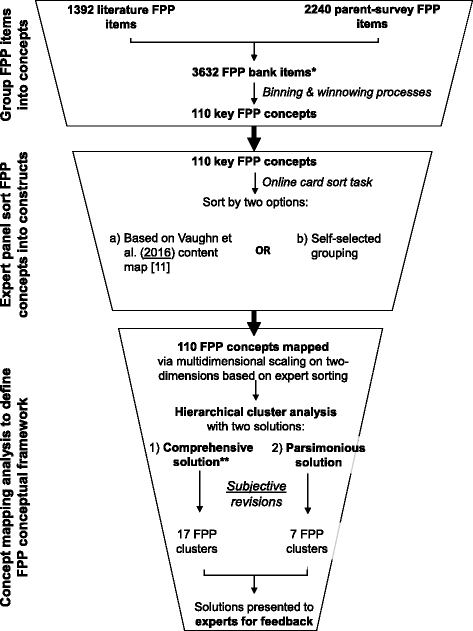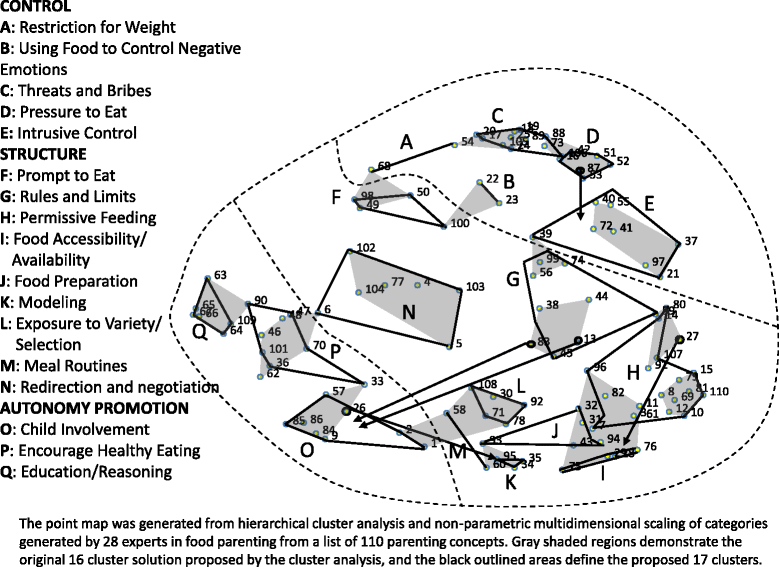Food parenting practices for 5 to 12 year old children: a concept map analysis of parenting and nutrition experts input
- PMID: 28893273
- PMCID: PMC5594481
- DOI: 10.1186/s12966-017-0572-1
Food parenting practices for 5 to 12 year old children: a concept map analysis of parenting and nutrition experts input
Abstract
Background: Parents are an important influence on children's dietary intake and eating behaviors. However, the lack of a conceptual framework and inconsistent assessment of food parenting practices limits our understanding of which food parenting practices are most influential on children. The aim of this study was to develop a food parenting practice conceptual framework using systematic approaches of literature reviews and expert input.
Method: A previously completed systematic review of food parenting practice instruments and a qualitative study of parents informed the development of a food parenting practice item bank consisting of 3632 food parenting practice items. The original item bank was further reduced to 110 key food parenting concepts using binning and winnowing techniques. A panel of 32 experts in parenting and nutrition were invited to sort the food parenting practice concepts into categories that reflected their perceptions of a food parenting practice conceptual framework. Multi-dimensional scaling produced a point map of the sorted concepts and hierarchical cluster analysis identified potential solutions. Subjective modifications were used to identify two potential solutions, with additional feedback from the expert panel requested.
Results: The experts came from 8 countries and 25 participated in the sorting and 23 provided additional feedback. A parsimonious and a comprehensive concept map were developed based on the clustering of the food parenting practice constructs. The parsimonious concept map contained 7 constructs, while the comprehensive concept map contained 17 constructs and was informed by a previously published content map for food parenting practices. Most of the experts (52%) preferred the comprehensive concept map, while 35% preferred to present both solutions.
Conclusion: The comprehensive food parenting practice conceptual map will provide the basis for developing a calibrated Item Response Modeling (IRM) item bank that can be used with computerized adaptive testing. Such an item bank will allow for more consistency in measuring food parenting practices across studies to better assess the impact of food parenting practices on child outcomes and the effect of interventions that target parents as agents of change.
Keywords: Child; Concept mapping; Family; Food; Measurement; Nutrition; Parenting; Parenting practices.
Conflict of interest statement
Ethics approval and consent to participate
The protocol was approved by the Institutional Review Boards at the University of British Columbia and Baylor College of Medicine.
Consent for publication
The Experts provided consent for participating in this study. Those acknowledged by name provided approval for us to acknowledge their participation.
Competing interests
The authors declare that they have no competing interests.
Publisher’s Note
Springer Nature remains neutral with regard to jurisdictional claims in published maps and institutional affiliations.
Figures


Similar articles
-
Calibration of the food parenting practice (FPP) item bank: tools for improving the measurement of food parenting practices of parents of 5-12-year-old children.Int J Behav Nutr Phys Act. 2020 Nov 16;17(1):140. doi: 10.1186/s12966-020-01049-9. Int J Behav Nutr Phys Act. 2020. PMID: 33198790 Free PMC article.
-
Development of an item bank for food parenting practices based on published instruments and reports from Canadian and US parents.Appetite. 2016 Aug 1;103:386-395. doi: 10.1016/j.appet.2016.04.033. Epub 2016 Apr 27. Appetite. 2016. PMID: 27131416
-
Conceptualizing physical activity parenting practices using expert informed concept mapping analysis.BMC Public Health. 2017 Jun 14;17(1):574. doi: 10.1186/s12889-017-4487-1. BMC Public Health. 2017. PMID: 28615050 Free PMC article.
-
How to bridge the intention-behavior gap in food parenting: Automatic constructs and underlying techniques.Appetite. 2018 Apr 1;123:191-200. doi: 10.1016/j.appet.2017.12.016. Epub 2017 Dec 24. Appetite. 2018. PMID: 29277519 Review.
-
Fundamental constructs in food parenting practices: a content map to guide future research.Nutr Rev. 2016 Feb;74(2):98-117. doi: 10.1093/nutrit/nuv061. Epub 2016 Jan 2. Nutr Rev. 2016. PMID: 26724487 Free PMC article. Review.
Cited by
-
Children's eating behaviours and related constructs: conceptual and theoretical foundations and their implications.Int J Behav Nutr Phys Act. 2023 Feb 15;20(1):19. doi: 10.1186/s12966-023-01407-3. Int J Behav Nutr Phys Act. 2023. PMID: 36793039 Free PMC article. Review.
-
Calibration of the food parenting practice (FPP) item bank: tools for improving the measurement of food parenting practices of parents of 5-12-year-old children.Int J Behav Nutr Phys Act. 2020 Nov 16;17(1):140. doi: 10.1186/s12966-020-01049-9. Int J Behav Nutr Phys Act. 2020. PMID: 33198790 Free PMC article.
-
An examination of food parenting practices: structure, control and autonomy promotion.Public Health Nutr. 2019 Apr;22(5):814-826. doi: 10.1017/S1368980018003312. Epub 2018 Dec 18. Public Health Nutr. 2019. PMID: 30561294 Free PMC article.
-
Application of latent profile analysis to define subgroups of parenting styles and food parenting practices.Appetite. 2019 Aug 1;139:8-18. doi: 10.1016/j.appet.2019.04.001. Epub 2019 Apr 6. Appetite. 2019. PMID: 30965046 Free PMC article.
-
Primary Disease Prevention for Southwest American Indian Families During the COVID-19 Pandemic: Camp in a Box.Front Sociol. 2021 Mar 9;6:611972. doi: 10.3389/fsoc.2021.611972. eCollection 2021. Front Sociol. 2021. PMID: 33869562 Free PMC article.
References
MeSH terms
Grants and funding
LinkOut - more resources
Full Text Sources
Other Literature Sources
Medical

